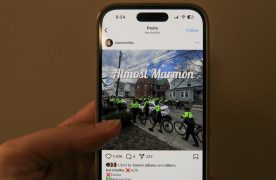Much of the bustling city of Boston is on self-enforced lockdown. Daily life is in a state of transformation as residents learn to live in homebound isolation.
The streets lay almost bare and rush hour traffic is virtually nonexistent. But signs of life persist even as all normalcy seems to wane:
A man walks his dog with a face covering on. Customers stand six feet apart in line at the grocery store. An elderly couple carry their purchases home as an oncoming jogger steps out onto the street to create a wide berth as they pass.
Several small businesses are now shuttered, while others struggle to survive. Many lines of work have shifted to remote operation.
How did we get here?
The novel coronavirus first entered Massachusetts on Jan. 31, the same day the federal government declared the outbreak a public health emergency. The state announced a confirmation on Feb. 1.
A University of Massachusetts Boston student had tested positive for COVID-19 after returning to Boston on a flight from Wuhan, China — the presumed origin of the virus that had begun to span the globe.
For the next month, things remained calm in the Commonwealth as local health officials monitored the situation with no findings of new cases. Risk remained low in the state, the Massachusetts Department of Public Health reported throughout February.
The DPH recommended the public take the same precautions as those against seasonal influenza: hand-washing, covering coughs and sneezes and staying home when feeling sick.
On a fact sheet published on Feb. 27, neither the state nor the medical community at large advised that people should wear face masks in public unless they already suffered from a respiratory illness.
Then, in early March, cases began to rise. One new Massachusetts confirmation appeared on March 2, then another on March 5. The next day, three were confirmed in Boston — and the uptick rolled into a surge.
On March 9, Boston’s annual St. Patrick’s Day Parade became the first major gathering in the state to be canceled due to coronavirus concerns.
That morning also marked the first decision from a major Massachusetts university to shift all classes to online instruction, as Harvard University announced students must move out by the end of the week.
A slew of at least eight colleges followed suit on March 10, just as Gov. Charlie Baker declared a state of emergency in the Commonwealth, with more schools soon to join the bandwagon.
The number of COVID-19 cases in Massachusetts topped 100 on March 12.
By March 13, the Boston Marathon was postponed until September. This meant Boston’s longtime tradition, and the most prestigious marathon in the world, was halted for the first time since 1918 — yet the multitude of college students who typically celebrate had by now already scattered back to hometowns across the country.
Boston Mayor Marty Walsh then declared a public health emergency on March 15, the same day Baker issued a statewide emergency order prohibiting dining in at restaurants and bars, as well as gatherings of more than 25 people.
Over the next week, Boston Public Schools closed districtwide, with the deadline to reopen ultimately extended from April 27 to the end of the academic year. The Massachusetts Bay Transportation Authority began running on reduced hours, and the City of Boston suspended all non-emergency construction work.
Another emergency order by Baker on March 23 shut down on-site operations of all workplaces not deemed essential, a precaution later extended from its initial April 7 end date to May 4 and then again to May 18. Those exempt from the mandate included health care facilities, grocery stores and restaurants relying solely on takeout or delivery. And now, gatherings could not exceed 10 people.
Massachusetts reported more than 6,600 COVID-19 cases by the end of March, with nearly 90 deaths.
Come April, Boston had begun encouraging residents to wear face coverings while in public, ideally homemade reusable cloth ones to reserve essential medical-grade masks for front line workers.
The Boston Public Health Commission issued a public health advisory April 5 for all except non-essential workers to observe a 9 p.m. to 6 a.m. curfew. Residents should now leave their homes only to pick up necessities, according to City guidelines.
Many municipalities, Boston included, have imposed moratoriums on evictions as employment plummets, as well as continued providing free pick-up meals to public school students who rely on the provided food.
Massachusetts has extended its income tax filing deadline from April 15 to July 15, matching a newly extended federal tax deadline. The U.S. Department of Homeland Security extended its deadline to apply for a Real ID by one year, to Oct. 1, 2021.
The federal government has started to deliver stimulus checks of up to $1,200 to eligible individuals in mid-April, as part of a $2 trillion economic stimulus package. Meanwhile, Massachusetts has committed $500,000 to the issuance of grants to small businesses impacted by closures and lost revenue, as Boston offered up $3 million in City funds to help residents meet rent.
At the time of publication on April 29, Massachusetts has reported new 1,963 cases and 252 deaths, according to data from the MDPH — the highest single-day increase in fatalities yet. In total, the state now has 60,265 reported cases and 3,405 reported deaths.











